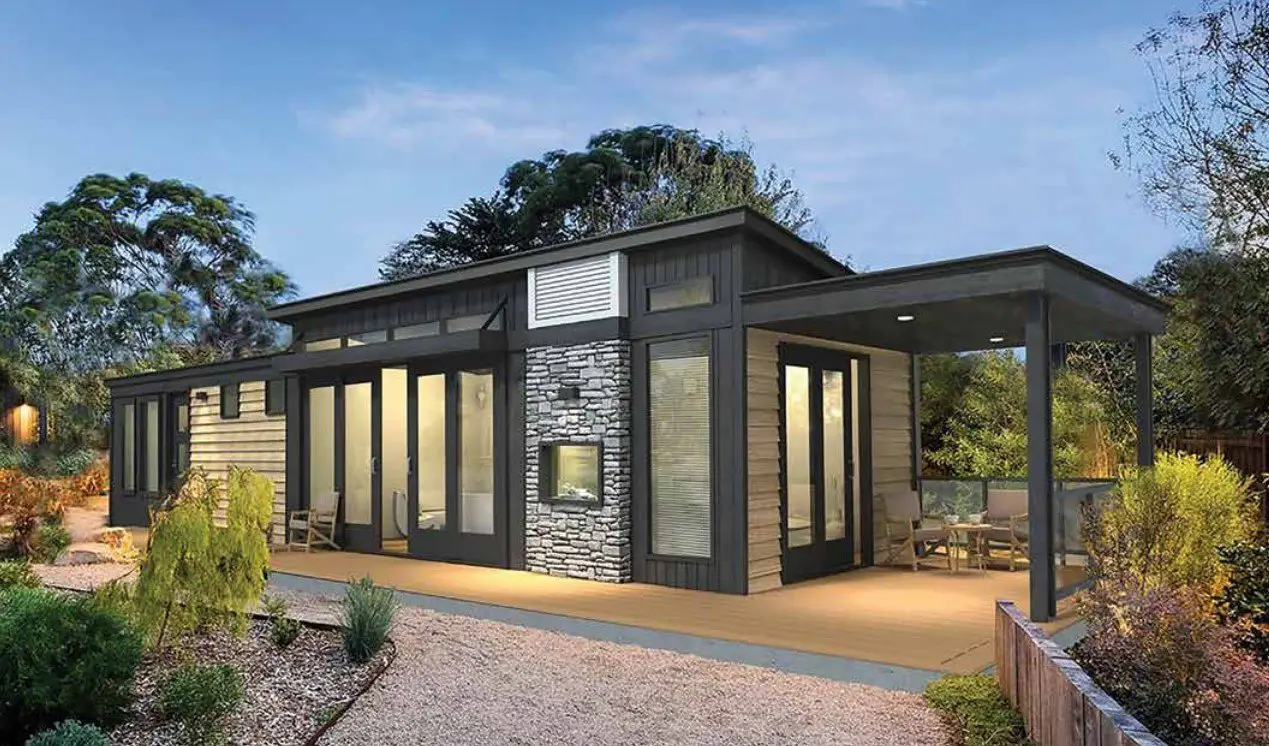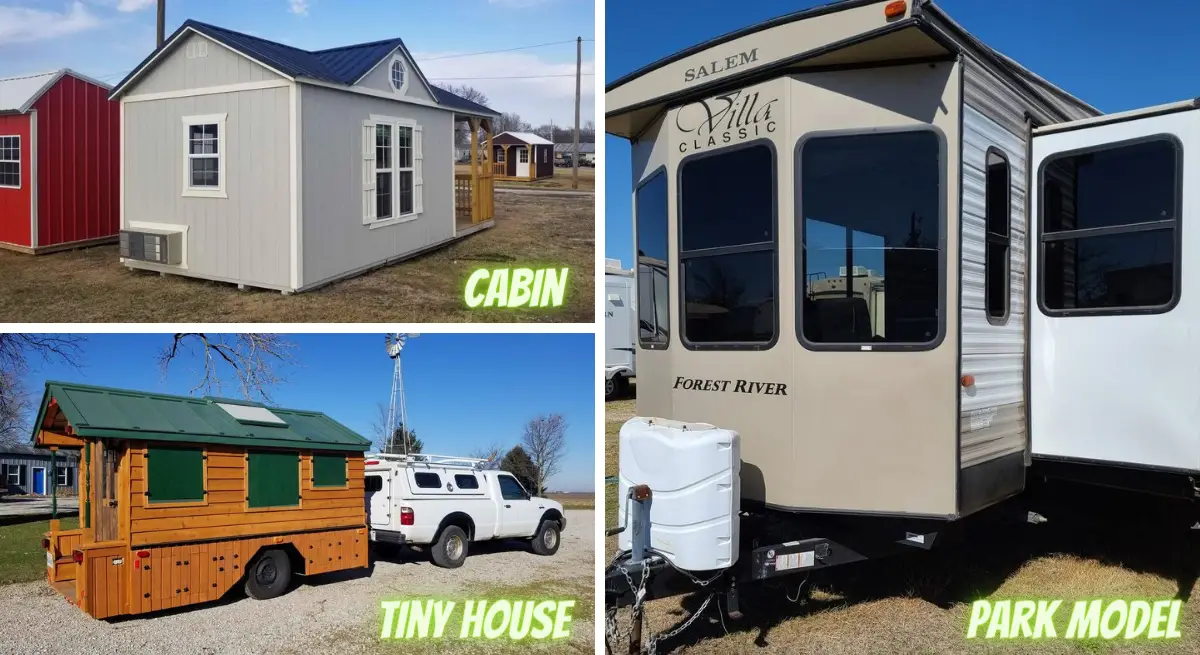A Park Model RV is an RV that is built according to the specifications set out by the RV associations in America and Canada. In Canada a Park Model is not to exceed 50 m2 (538 sq ft) in the USA it is not to exceed 400 sq feet. With the other specifications being very similar in both countries. There may also be certain specifications for each state and province with regards to this type of RV. Park Model RVs are meant to be towed to a location and parked and not towed from location to location such as a typical trailer or 5th wheel. Like other RVs it is not designed to be lived in on a full time basis. The Tiny house movement has sparked more interest in Park Model RVs in the last few years, but there is a difference between the two.
Park Model RV Vs A Tiny House
Tiny houses and Park Model RVs share many similarities. One could easily mistake a tiny house for a park model RV. The primary differences are that a tiny house falls under the building codes for each state and province and are built on a foundation or built in a factory and moved to a location. Park Models in Canada must follow the standards set out by the Standards Council of Canada (CAN/CSA-Z241 Series-92 (R1998)) . In the States, it is determined by the RV Industry Association (RVIA) and is laid out by ANSI A119.5 for the standards that which a park model is to be built.
As for Tiny houses, there’s currently no real building definition in the building code with reference to a “Tiny house.” But if it is meant to be inhabited for some period of time, then the construction of the house must still abide by the set out building codes of each country. While the park model is built on a platform on wheels and follows the code set out by RVIA or CSA. Here’s a list of other differences between a park model and a tiny house.
| Feature | Tiny House | Park Model RV |
|---|---|---|
| Size | Typically 400 sq ft up to 1000 sq ft | Not to exceed 400 sq ft in USA & 538 in Canada |
| Regulations | Construction Building codes | RVIA in USA /Canada CSA |
| Foundation or Base | Built on permanent Foundation | Platform on wheels and designed to be towed |
| Where Built | Onsite or factory and built on site | Certified RV factory |
| Parking | lake lot or urban property | RV park or lake lot |
| Price | 10k to unlimited | 20k to 150k |
| mortgage | Can get but difficult | no |
| Ownership | Real Property (chattel) | Vehicle or RV |
| Construction | Can be self built, or built by home builder | Built by certified RV Factory |
| Insurance | Property Insurance | RV Insurance |
| Registration | If required for property | RV or vehicle registration |
Choosing: Tiny House or Park Model?
Deciding to put a Tiny house or Park Model on a lot by the lake or lot can be a difficult decision. After all they are very similar in look, initially. Let’s start with the location of the final resting place for your home for enjoyment.
- Are you putting it on your property in the city or is going to be at a campground
- Do you own the land or is it rented?
- Are you planning on living in it full time or part time or seasonal?
- Are you planning on moving it to another location at some point?
- Would you build it or buy?
- What is the minimum space you need for your family or you? (is it larger than 400 sq ft)
- Are there any restrictions on what you can put on the property?
Ultimately, these are the questions that will determine what you end either with a house or park model. Either have their advantages and disadvantages. A tiny house can be considered property attached to land and would be sold as real estate, along with all that comes along land, such as loans and title with chattels. It is also subject to increasing and decreasing real estate prices based on economics and demand for the area. While a park model is considered a vehicle and not property and would be subject to licensing and certifications such as vehicles. The vehicle or park model depreciates like all vehicles.
How to Move A Park Model RV?
Do Park Models Have Wheels?
Park Model RVs have wheels and can be towed like a trailer but meant to be stationary, though they do fall under the requirements to be towed on the highway and can be done so without typically a special permit. By all respects they are considered an RV and would need the typical RV registration, certifications, and license plating required by each state or province. The typical model weights at approximately 10,000 lbs to 13, 000 lbs and so could be towed by a heavy duty truck such as a F450 truck. However, some park models are a little wider and taller and would require commercial mover to move your park model.
Park Model Vs Other Types Of RVs (Motorhomes, Trailers, 5th wheels)
Typical RVs such as motorhomes and trailers are designed to be moved relatively often as compared with a park model RV that are not. The biggest differences between the two are that park models lack fresh water, dark water and grey water tanks. They are designed like a house to be plumbed in on location at a campground. The building materials for windows and doors are more like that of a residential house. While typical RVs appliances (stove, fridge), sinks, and toilets are small and lightweight. The other is that the park models tend to look more like a house, while RVs look more vehicle like or trailer like.
Park Model Summary
Park model RVs are the least like the typical RVs on the road today. They do fill a niche in the RV world where it is about vacation and enjoyment. Tiny houses also fill a niche that of a small footprint, and lower cost than the typical cabin or house by the lake or urban lot as a second home on a property. Tiny houses can be inhabited year round, while Park Models are designed for seasonal living. Sometimes tiny houses and park model RVs are indistinguishable as they both have similar characteristics. There are differences. Choosing one over the other has more to do with your particular situation than saying one is better than the other.



